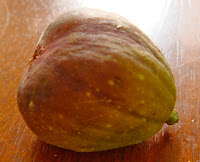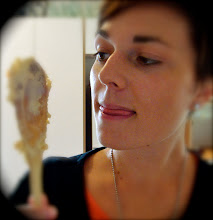
There's a lovely expression called 'bottling the season' that creeps under my skin when things are ripe and just begs me to dance a tango with fruit, sugar and the stove top. Bottling it, jamming it, preserving it- I just love taking fruit when it's fresh and stockpiling it as jams and chutneys for a rainy cold day with open fires and crumpets.
That's the joy of seasons, you can look forward to the ones ahead, whilst still enjoying the one currently on offer.
Today at the local IGA I was greeted by a tray of ready-to-go blood plums; perfect to eat right now, but sitting there at a discount price it seemed a tray just made for jamming.
Jam making is one of those things that you either have time for, or you don't. Luckily today I was in research mode for an article I'm writing and had plenty of time at the computer ahead of me. So what better way to be doubly productive than to get a pot of jam on the boil and babysit it while I'm working?
Now I recognise that not everyone has a kitchen at their disposal during work hours -sadly I don't always have this luxury either- but jamming is a great thing to do whenever you've got stuff that's holding you at home. I grew up in a house where mum made marmalade (mum-alade) whilst helping us with our homework, and I reckon I might give it ago next time I've got a bit of DVD watching planned.
Trust me, home made jam is totally worth the odd break or two in a movie.
Easy and relatively quick Plum & Rosewater Jam:
Ingredients:
- 1kg ripe blood plums- washed, quartered and de-stoned
- 2 cups boiling water
- 2 tablespoons lemon juice
- 3 cups sugar
- 1 teaspoon rosewater (I usually just add a dash of my own measure, but if you don't have it, just leave it out)
Five ingredients- that's it! No stuffing round with pectin in this recipe! And the rosewater just gives it that extra-sexy aroma to tanalise and warm you in the winter months. What could be better than a jar of rose scented plums? It's just that tiny point of difference.
Method:

First- place a small plate or saucer into the fridge to chill, this is for the set test later on.
Next- make sure you have some clean and sterilised jars on hand so that the jam will keep when bottled.
*See note below on sterilising*
Place the plums and boiling water into a heavy based saucepan on high heat. Bring to the boil and then simmer uncovered for about an hour. Check occasionally to make sure it hasn't done anything weird and is just happily bubbling away.
The plums should be nice a soft by this time, the skins will have mostly peeled away, but the quarters will still be holding their shape a little. Some people like to take the skins out, but I reccommed leaving them in for the rustic feel and for colour. Jams are just better when they are chunky and full of real bits.
Reduce the heat to low and add the lemon juice and sugar and stir- without boiling- until the sugar is completely dissolved. If you taste it now it's like really syrupy plum cordial.
Then bring the pan up to a rapid boil, reduce to a steady boil and leave bubbling away uncovered for 30mins.
Check to see how the set of the jam is going
*see note below on testing jam set* and if it's not quite at setting point, boil it for another 15mins and do the set test again. At the last minute stir through the rosewater just to give it that wonderful (extra) sexy fragrance- a little bit of Eastern flair with your scones.
Once your jam has a good set, spoon it into the sterilised jars (I always spill plenty) and seal it up whilst hot to create a good seal and then let it cool for storage.
Just think of all the joy those crumpets are gonna get come mid-winter tea and toast!
Wether you choose to decorate the lids with little fabric caps is up to you- I can't help myself, if I'm playing Nanna, I just have to go the whole hog. So yes, I am one of those neighbours who pops in with a jar of jam... tea anyone?
*Setting test: Place a dollop of the jam onto the chilled saucer from the fridge, pop it back in the firdge for a minute, then take it out and run your finger through it to separate it in half. If it stays in two distinct parts then it's ready and has a good set. If not, just boil it a little longer. How much set you go with is up to you. I don't like my jam to get too jellied up.
*Sterisling bottles/jars: You can do this by heating them in the oven for 15minutes or by boiling them in a pot on the stove for 5minutes or so. I'm no expert- but fingers crossed my jams don't seem to have any problems if they are stored in cool places. Either way, just remember to heat the jars slowly otherwise they might break, and jam making is messy enough without broken glass everywhere too.
 Get your buns in the oven: SBS
Get your buns in the oven: SBS






















